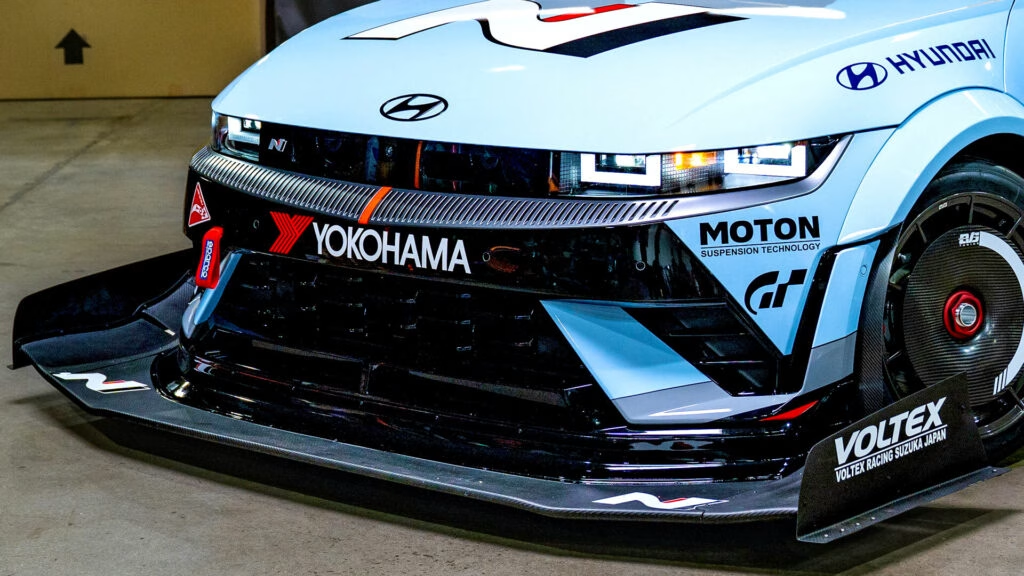Hyundai is gearing up for an exciting challenge at the Pikes Peak International Hill Climb with a specially modified version of the Ioniq 5 N. This isn’t just any electric vehicle; it’s a one-off creation designed in collaboration with Evasive Motorsports, and it’s set to tackle the iconic 12.42-mile course on June 22. Behind the wheel will be Rob Walker, a seasoned driver known for his previous work with the Scion FR-S.
What makes this Ioniq 5 N stand out? For starters, it’s undergone a significant transformation, shedding a whopping 500 pounds (227 kg) thanks to an extensive use of carbon fiber components. This weight reduction is crucial for performance, especially on a demanding course like Pikes Peak, where every ounce counts. The interior has been stripped down, and new carbon fiber doors and a tailgate have been crafted to enhance both weight savings and aerodynamics.
### How Did They Achieve Such a Radical Transformation?
One of the biggest challenges faced by Evasive Motorsports was sourcing competition parts for the Ioniq 5 N, as options are limited for this model. Fortunately, Japan’s Voltex stepped in to create a bespoke aerodynamic body kit. This kit includes a carbon fiber splitter, bulging fender flares, and new side skirts, all designed to improve downforce and stability at high speeds. Additionally, the car features carbon fiber underbody paneling and a massive rear wing, which are vital for enhancing aerodynamics.
To further boost its performance, the Ioniq 5 N is equipped with Krontec air jacks and 19-inch Titan racing wheels fitted with Yokohama racing slicks. Safety and handling are also top priorities, with a six-point roll cage and a Moton coilover suspension featuring prototype anti-roll bars from EVS Tuning. The finishing touch is a Sparco carbon fiber seat, ensuring that the driver is both secure and comfortable during the intense race.
### What About Power and Performance?
While the electric motors in the Ioniq 5 N can’t be tuned, the vehicle still boasts a formidable dual-motor all-wheel drive system. This setup delivers up to 641 horsepower (478 kW / 650 PS) and 568 lb-ft (769 Nm) of torque. For context, the road-going version of this model can accelerate from 0 to 60 mph in just 3.25 seconds, reaching a top speed of 162 mph (261 km/h).
Evasive Motorsports co-president Mike Chang has set an ambitious goal for this year’s race: to break the elusive 10-minute barrier. “We’ve come close in the past and feel it’s far more achievable with the Ioniq 5 N,” he remarked. This goal is not just about speed; it’s about pushing the boundaries of what electric vehicles can achieve in a competitive setting.
### Why Pikes Peak?
The Pikes Peak International Hill Climb is often referred to as “The Race to the Clouds.” It’s a unique event that challenges drivers with its steep climbs, sharp turns, and ever-changing weather conditions. The race has a storied history, attracting a diverse range of vehicles and drivers, from traditional combustion engines to cutting-edge electric cars.
Hyundai’s participation with the Ioniq 5 N not only showcases their commitment to performance EVs but also highlights the growing trend of electric vehicles in motorsport. As technology advances, the line between performance and sustainability continues to blur, making events like Pikes Peak a perfect platform for innovation.
### What Can We Expect?
As the race day approaches, excitement is building around the Ioniq 5 N’s potential. With its impressive modifications and a driver like Rob Walker at the helm, there’s a palpable sense of anticipation. Will they break the 10-minute mark? Only time will tell, but one thing is for sure: this race will be a thrilling showcase of engineering prowess and electric performance.
The big takeaway? The Ioniq 5 N isn’t just about speed; it’s about pushing the limits of what’s possible in electric vehicle technology. Whether you’re a motorsport enthusiast or just curious about the future of EVs, keep an eye on this race. It could redefine how we think about performance in the electric age.

